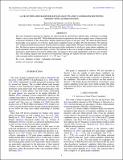| dc.contributor.author | Demory, Brice-Olivier | |
| dc.contributor.author | Seager, Sara | |
| dc.date.accessioned | 2012-10-22T13:58:34Z | |
| dc.date.available | 2012-10-22T13:58:34Z | |
| dc.date.issued | 2011-11 | |
| dc.date.submitted | 2011-08 | |
| dc.identifier.issn | 0004-637X | |
| dc.identifier.issn | 1538-4357 | |
| dc.identifier.uri | http://hdl.handle.net/1721.1/74172 | |
| dc.description.abstract | The most irradiated transiting hot Jupiters are characterized by anomalously inflated radii, sometimes exceeding Jupiter's size by more than 60%. While different theoretical explanations have been applied, none of them provide a universal resolution to this observation, despite significant progress in the past years. We refine the photometric transit light curve analysis of 115 Kepler giant planet candidates based on public Q0-Q2 photometry. We find that 14% of them are likely false positives, based on their secondary eclipse depth. We report on planet radii versus stellar flux. We find an increase in planet radii with increased stellar irradiation for the Kepler giant planet candidates, in good agreement with existing hot Jupiter systems. We find that in the case of modest irradiation received from the stellar host, giant planets do not have inflated radii, and appear to have radii independent of the host star incident flux. This finding suggests that the physical mechanisms inflating hot Jupiters become ineffective below a given orbit-averaged stellar irradiation level of ~2 × 10[superscript 8] erg s[superscript –1] cm[superscript –2]. | en_US |
| dc.description.sponsorship | United States. National Aeronautics and Space Administration (Kepler Participating Science Program Grant NNX08BA51G) | en_US |
| dc.language.iso | en_US | |
| dc.publisher | IOP Publishing | en_US |
| dc.relation.isversionof | http://dx.doi.org/10.1088/0067-0049/197/1/12 | en_US |
| dc.rights | Article is made available in accordance with the publisher's policy and may be subject to US copyright law. Please refer to the publisher's site for terms of use. | en_US |
| dc.source | IOP | en_US |
| dc.title | Lack of Inflated Radii for Kepler Giant Planet Candidates Receiving Modest Stellar Irradiation | en_US |
| dc.type | Article | en_US |
| dc.identifier.citation | Demory, Brice-Olivier, and Sara Seager. “Lack of Inflated Radii for Kepler Giant Planet Candidates Receiving Modest Stellar Irradiation.” The Astrophysical Journal Supplement Series 197.1 (2011): 12. © 2011 IOP Publishing | en_US |
| dc.contributor.department | Massachusetts Institute of Technology. Department of Earth, Atmospheric, and Planetary Sciences | en_US |
| dc.contributor.mitauthor | Demory, Brice-Olivier | |
| dc.contributor.mitauthor | Seager, Sara | |
| dc.relation.journal | Astrophysical Journal | en_US |
| dc.eprint.version | Final published version | en_US |
| dc.type.uri | http://purl.org/eprint/type/JournalArticle | en_US |
| eprint.status | http://purl.org/eprint/status/PeerReviewed | en_US |
| dspace.orderedauthors | Demory, Brice-Olivier; Seager, Sara | en |
| dc.identifier.orcid | https://orcid.org/0000-0002-6892-6948 | |
| mit.license | PUBLISHER_POLICY | en_US |
| mit.metadata.status | Complete | |
